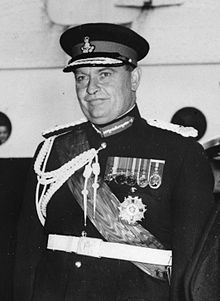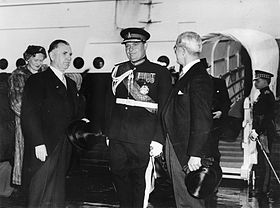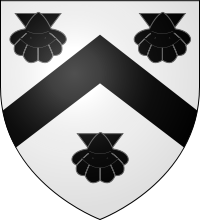- Charles Lyttelton, 10th Viscount Cobham
-
The Right Honourable
The Viscount Cobham
KG, GCMG, GCVO, TD, PC
Lord Cobham in September 1957 9th Governor-General of New Zealand In office
5 September 1957 – 13 September 1962Monarch Elizabeth II Preceded by The Lord Norrie Succeeded by Bernard Fergusson Personal details Born 8 August 1909
Kensington, London
United KingdomDied 20 March 1977 (aged 67)
Marylebone, London
United KingdomLord Cobham Personal information Full name Charles John Lyttelton, 10th Viscount Cobham Born 8 August 1909
Kensington, EnglandDied 20 March 1977 (aged 67)
Marylebone, EnglandBatting style Right-hand Bowling style Right-arm medium Role Bowler Domestic team information Years Team 1932–1939 Worcestershire 1935–1936 MCC First-class debut 25 June 1932
Worcestershire v GloucestershireLast First-class 24 February 1961
New Zealand Governor's XI v MCCCareer statistics Competition FC Matches 104 Runs scored 3,181 Batting average 20.26 100s/50s 1/13 Top score 162 Balls bowled 2,195 Wickets 32 Bowling average 41.18 5 wickets in innings 0 10 wickets in match 0 Best bowling 4/83 Catches/stumpings 52/– Source: cricketarchive.com, 14 August 2007 Charles John Lyttelton, 10th Viscount Cobham, KG, GCMG, GCVO, TD, PC (8 August 1909 – 20 March 1977) was the 9th Governor-General of New Zealand and English cricketer.
Contents
Early life and family
Charles Lyttelton was born in Kensington, London, the son of Violet Yolande Leonard and her husband, John Lyttelton, 9th Viscount Cobham.[1] He was educated at Eton College and Cambridge. He graduated with a law degree in 1932.[2]
He had a family connection to New Zealand, where he was to become Governor-General, through his great-grandfather George Lyttelton, 4th Baron Lyttelton, who was chairman of the Canterbury Association and had contributed financially to the early development of Christchurch. Hagley Park is named after their family estate, and the port town of Lyttelton bears his great-grandfather's name.[1]
Viscount Cobham visited New Zealand in 1950 in relation to property holdings in Christchurch.[1]
Lyttelton married Elizabeth Alison Makeig-Jones on 30 April 1942 at Chelsea in central London. The marriage produced four sons and four daughters.[1] He was cousin of the musician Humphrey Lyttelton.
Military service
Lyttelton joined the Territorial Army in 1933. He serviced in World War II with the Expeditionary Force in France from 1940. He was commander of the 5th Regiment from 1943.[1]
Politics
 Lord Cobham (centre) arriving in Wellington in September 1957. Prime Minister Sidney Holland (left) and Sir Harold Eric Barrowclough stand alongside.
Lord Cobham (centre) arriving in Wellington in September 1957. Prime Minister Sidney Holland (left) and Sir Harold Eric Barrowclough stand alongside.
After the war, he wanted to follow in his father's footsteps and enter the House of Commons. However, his father died in 1949, and Lyttelton was elevated to the peerage, precluding a career as a Commoner.[1]
Viscount Cobham became the ninth Governor-General of New Zealand on 5 September 1957. Although from aristocratic background, he proved popular with the population. He was seen as an outdoors man with a sporting prowess in cricket, golf, and a competent rugby judge. He was good with a gun and an enthusiastic fly fisherman. All these attributes resonated well with New Zealanders.[1]
Significant events during his tenure included the independence of Samoa and the opening of the Auckland Harbour Bridge.[3][4]
Cobham served under three Prime Ministers: Sidney Holland (1949–1957), Keith Holyoake (1957 and 1960–1972) and Walter Nash (1957–1960). He was most careful to not comment on controversial matters, and had a good working relationship with all three of them.[1]
Cobham was instrumental in setting up the outdoor education organisation Outward Bound in New Zealand. He opened the Outward Bound school in Anakiwa near Picton in September 1962, which bears his name. He visited the school again during 1966 and was pleased with the progress that had been made.[1]
He served until 13 September 1962. He was a skilled orator and a book of his speeches sold 50,000 copies. Cobham donated the £10,000 profit to Outward Bound. Cobham Oval in Whangarei and Cobham Court in Porirua are named after him.[1]
Cricket
Lyttelton enjoyed a fairly substantial career in first-class cricket, playing more than 90 times for Worcestershire in the 1930s and captaining the club between 1936 and 1939.
He made his first-class debut against Gloucestershire in June 1932, but made a duck in his only innings and did not reappear for two years. He played five times in 1934, but it was only the following season that he became established in the side, playing about twenty matches a year from then until the Second World War, with the exception of 1937 when he appeared only twice.
Lyttelton's highest score (and only first-class century) was the 162 he made against Leicestershire in 1938, but he made many other useful if lesser contributions with the bat, reaching fifty on 14 further occasions. His most productive year was 1938, when he scored 741 runs at an average of 21.17.
With the ball, his first victim (in July 1934) was Charlie Barnett, while in 1935 he produced his best innings' bowling, claiming 4–83 against the South Africans. However, after 1935 his bowling became a largely occasional part of his game, and with the exception of nine wickets in 1938 he never again took more than three in a season.
Lyttelton's cricketing career proper ended with the outbreak of war, but (now listed on the scorecard as Lord Cobham, having succeeded to the title in 1949) he played for an "MCC New Zealand Touring Team" against a strong "London New Zealand Club" side in 1954, taking two wickets including that of Bill Merritt. Remarkably, however, he made a one-off return to first-class action aged 51 in February 1961, more than two decades after his previous appearance at that level, when as New Zealand Governor-General he captained an eponymous side against MCC at Auckland; he showed he still had ability with a handy first-innings 44 from number ten in the order.
As well as the matches mentioned above, Lyttelton also played ten games for MCC: one against Oxford University in 1935, and nine on MCC's tour of Australia and New Zealand during the winter that followed.
A number of his relatives played first-class cricket. His great-grandfather George played for Cambridge University in the 1830s, his grandfather (also Charles) turned out for a selection of teams including Cambridge and MCC in the 1860s, his father John made a handful of appearances for Worcestershire in the 1920s, and his uncle – another Charles – played for Worcestershire, Cambridge and MCC before the First World War.
Death
Cobham died in Marylebone, London, on 20 March 1977. He was survived by his wife and children.[1]
Arms
References
- ^ a b c d e f g h i j k McGibbon, Ian (updated 1 September 2010). "Cobham, Charles John Lyttelton – Biography". Dictionary of New Zealand Biography. http://www.teara.govt.nz/en/biographies/5c27/1. Retrieved 11 January 2011.
- ^ "Viscount Cobham, GCMG, TD". The Governor-General. http://www.gg.govt.nz/node/1354. Retrieved 11 January 2011.
- ^ AHB Opening Video: http://www.fatlady.co.nz/cgi-bin/video.cgi?1170505503
- ^ Auckland Harbour Bridge Authority Record of 20 Years Activities 1951–1971
External links
- Official biography (Government House, Wellington)
- Player profile: Charles Lyttelton, 10th Viscount Cobham from ESPNcricinfo
- Statistical summary from CricketArchive
Sporting positions Preceded by
Cyril WaltersWorcestershire County Cricket Captain
1936–1939Vacant no cricket 1940–1945Title next held bySandy SingletonPolitical offices Preceded by
The Lord NorrieGovernor-General of New Zealand
1957–1962Succeeded by
Sir Bernard FergussonPreceded by
The Duke of WestminsterLord Steward
1967–1972Succeeded by
The Duke of NorthumberlandHonorary titles Preceded by
Sir William TennantLord Lieutenant of Worcestershire
1963–1974Office abolished Preceded by
The Marquess of SalisburyChancellor of the Order of the Garter
1972–1977Succeeded by
The Marquess of AbergavennyPeerage of Great Britain Preceded by
John LytteltonViscount Cobham
1949–1977Succeeded by
John LytteltonGovernors and Governors-General of New Zealand William Hobson* · Robert FitzRoy* · George Grey* · Thomas Gore Browne* · George Bowen* · Sir James Fergusson, Bt* · The Marquess of Normanby* · Hercules Robinson* · Arthur Hamilton-Gordon* · William Jervois* · The Earl of Onslow* · The Earl of Glasgow* · The Earl of Ranfurly* · The Lord Plunket* · The Lord Islington* · The Earl of Liverpool* · The Viscount Jellicoe · Sir Charles Fergusson, Bt · The Viscount Bledisloe · The Viscount Galway · Sir Cyril Newall · The Lord Freyberg · The Lord Norrie · The Viscount Cobham · Bernard Fergusson · Arthur Porritt · Denis Blundell · Keith Holyoake · David Beattie · Paul Reeves · Catherine Tizard · Michael Hardie Boys · Silvia Cartwright · Anand Satyanand · Jerry Mateparae
* Held office of Governor of New Zealand.
William Cavendish-Bentinck, 6th Duke of Portland · E. F. L. Wood, 1st Earl of Halifax · Robert Gascoyne-Cecil, 5th Marquess of Salisbury · Charles Lyttelton, 10th Viscount Cobham · John Nevill, 5th Marquess of Abergavenny · Peter Carington, 6th Baron Carrington
Categories:- English cricketers
- Governors-General of New Zealand
- Knights Grand Cross of the Royal Victorian Order
- Knights Grand Cross of the Order of St Michael and St George
- Knights of the Garter
- Lord-Lieutenants of Worcestershire
- Marylebone Cricket Club cricketers
- Members of the Privy Council of the United Kingdom
- Old Etonians
- Viscounts in the Peerage of Great Britain
- Worcestershire cricketers
- Worcestershire cricket captains
- 1909 births
- 1977 deaths
- People from Kensington
- British Army personnel of World War II
- Royal Artillery officers
Wikimedia Foundation. 2010.



